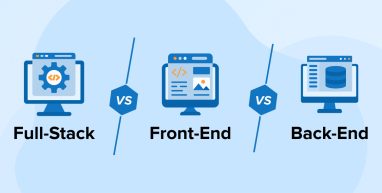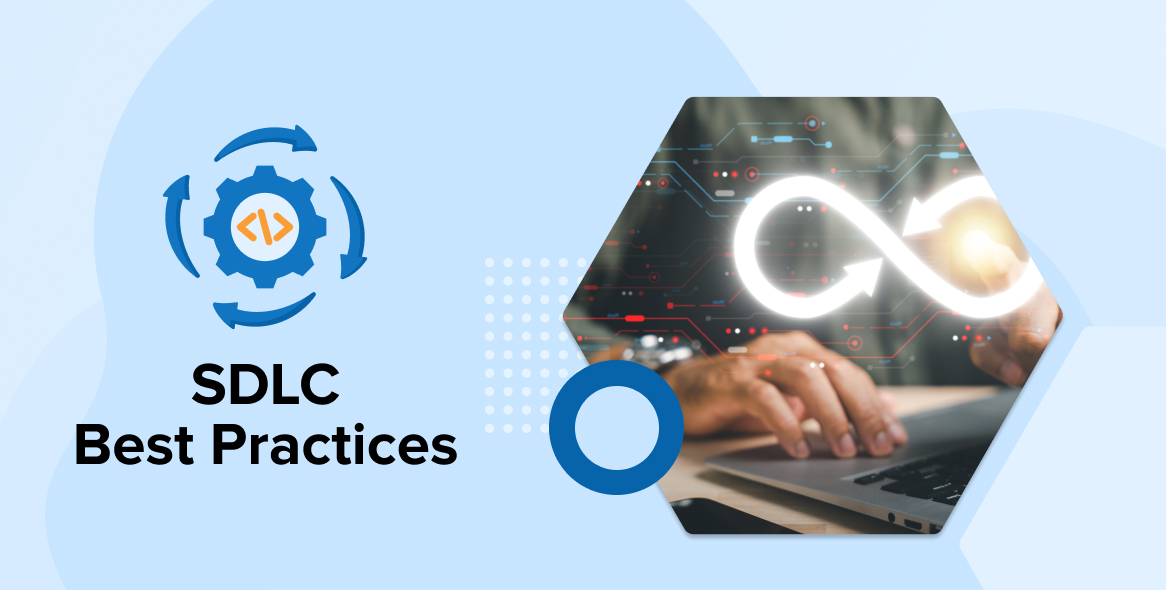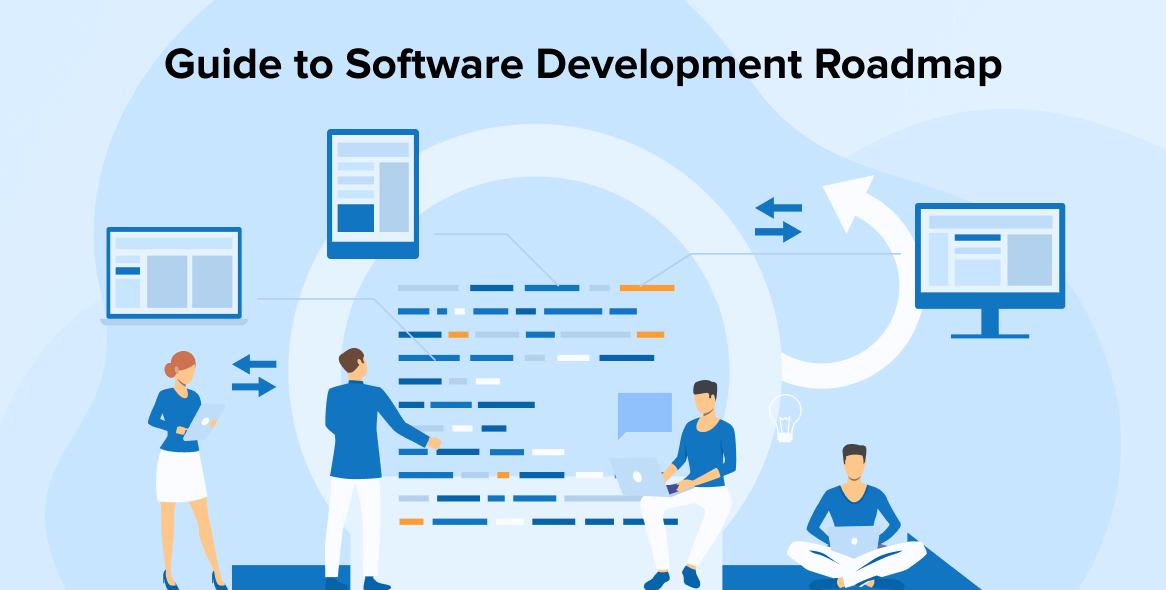
Web developers are the architects behind seamless site loading and appealing websites. A web developer’s role is quite diverse as well as stringent when it comes to responsibilities. This is because there are assigned developers who work on each type of functionality. So, the aesthetics that you see within your website or application is the art of front-end developers. The credit for a hassle-free website loading, and seamless shifts between web pages- all of it goes to backend developers. While there is someone who looks after both client-side and server-side are full-stack developers.
At this point, we might think that we are quite about with what all these three roles encompass. But, how to fit them in the software development job role requires you to know the skills of developers of all these three types.
1. Who are Full Stack Developers?
To start with a professional who is proficient in both skills is considered under this hood of full-stack developers. An individual who works on the front end and back end of a web application is known as a full-stack web developer. While the back end is in charge of the site’s architecture and logic in the background, the front end is in charge of the website’s aesthetic appearance and feel.
As a part of the Full-stack developer’s work role, let’s examine the front end and back end in more detail.
- Front-end Development aka Client-side development: A front-end developer designed every aspect of a web page including the logo, search bar, buttons, general layout, and user interface. The style and feel of the website are the control of front-end developers.
- Backend Development aka Server-side development: The Server-side back-end development is used to describe the area of an application that the user cannot view. Back-end developers concentrate on building servers, dealing with databases, and using APIs (Application Programming Interfaces).
1.1 Skills Required in a Full-Stack Developer
The technologies and tools you will need to master in order to become a developer with extraordinary full-stack developer skills are discussed below.
1. CSS and HTML
Front-end technologies prominently make use of the HTML language, also known as hypertext markup language. Developers utilize it to control the website’s text and image formatting and presentation. It controls the hierarchy of the webpage’s headings, paragraphs, bodies, pop-ups, and much more.
From a full stack developer’s perspective, the knowledge of HTML and CSS is a must expected check on the list. The HTML elements can be styled and changed using the style language known as CSS or Cascading Sheet Styles. If you want to offer your headings and paragraphs alternative colors, use CSS’s efficient customization tool to accomplish it.
2. JavaScript
JavaScript is an essential part of any discussion on full-stack developer skills. It’s one of the dynamic languages used by programmers to create more interactive front-ends. However, because of its dynamic nature, it might be applied to both server-side and client-side programming.
JavaScript makes the work of developers incredibly simple and effective because of its full integration with HTML and CSS and adaptability with important browsers. In addition to this, there are other frameworks for front-end development including Angular, React, React Native, and Vue.
A full-stack developer should have a basic understanding of JavaScript in addition to being aware of any newly introduced libraries or frameworks for the language’s ongoing development. A full-stack developer needs to be familiar with all of JavaScript’s features in order to succeed.
3. GitHub and Git
Without the infamous Git and GitHub, web development feels a little lacking. Especially for full-stack developers, it is well known among all novice as well as seasoned developers. To manage this at each tiny stage in the development process, developers use Git, a “distributed version control system.” One of the largest benefits of Git is its effectiveness in tracking and resolving errors, it differs from other control systems.
Developers can manage and review many projects on the GitHub platform at the same time. As the name implies, it establishes a center for networking and communication with other developers. Learning how these platforms function can help full-stack developers strengthen their leadership, teamwork, and management abilities.
2. Who are Front-End Developers?
In the web development process, Front end developers are the artists. They are the ones who build beautiful themes and graphical interfaces. They work cross-functionally to ensure that the website readily interacts with the page. A front-end developer has one primary duty and they do this by using a combination of programming, design, and technology to code a website’s aesthetic and handle troubleshooting. Each time you visit a website, the front-end developer is responsible for everything you view, click on, or otherwise use.
To design the outline or skeleton of a webpage, you need HTML, as you might know well. The body or skeleton of the website can be compared to CSS (Cascading Style Sheets). With the help of CSS, front-end web developers can alter how the shape of the website or application will be. This will be in terms of websites or any other equivalent set up for specific sections in advance to show the website in a particular way.
2.1 Skills Required for Front-End Development
There are many frontend developer skills that must be known by a developer to be skilled and proficient. Speaking of frontend development, it’s a broad area of online design and development that is utilized as a website’s frontend features. These are the ones that the end-user or client can see and use right away.
The majority of the time, a frontend developer is in control of everything you see, including the graphics and styling, themes and images, text and fonts, alignment, navigation, colors, and so forth. They also work to make the user experience as frictionless as possible. In addition to it they must have knowledge of content management systems.
Along with debugging, they also contribute to the aesthetic and overall design. Responsiveness and performance are the main objectives of front-end development. For businesses, some of the most common languages include;
- HyperText Markup Language (HTML)
- Cascading Style Sheets (CSS)
- JavaScript
- React
- Angular
- Vue
- jQuery
- Swift
2.2 Tools Required for Front-End Development
As per business-specific needs, there are several front-end web development tools available including the popular ones for HTML, CSS, and JavaScript, front-end code-editing, prototyping, wireframing, deployment, security, and many more. However, you need to consider a thousand things before you bank on a certain tool like business needs, the desired functions, ease of use, compatibility with other platforms, costs, etc.
- DevTools for Chrome: A popular web development tool called Chrome DevTools is a popular choice in front-end development. It enables you to quickly diagnose issues and edit web pages directly from the Google Chrome browser to create better websites.
- CSS file extension: One of the most popular CSS extension languages used globally is Sass. What Sass does is an aid to expand the capability of CSS by adding features like the ability to create variables, inline imports, inheritance, and simpler nesting.
- JQuery: In the field of web development, jQuery is a rather well-known name. It is a multi-platform JavaScript framework that supports many different capabilities including DOM manipulation, event handling, CSS manipulation, animation, support for Ajax and JSON, and much more.
- Git: It is a well-known version control system, It has an additional tool on this list. You can use it to handle the source codes.
- HTML5 Boiler Code: One of the most straightforward yet useful front-end web development tools available is HTML5 Boilerplate. You may use this tool to build faster, more reliable, and more flexible websites and applications.
3. Who are Back-End Developers in Web Development?
If a website’s front end is its visual appeal, its back end is the technical underpinnings of business logic. No matter how well a website looks, it can be useless if it does not function.
Databases as a part of the backend also play an equally vital role. Websites are built using PHP, often in conjunction with SQL. For use by the HTML files on the front end, information is taken from this database. Every time you check your news websites or update your social media accounts, you are probably using these languages without even realizing it. A database is increasingly required as a website’s need for information storage grows.
Tools like SQL Server and Oracle are used by back-end developers to store, manage, and modify data. PHP, Python, and JavaScript are a few of the most popular languages for back-end programming. Web developers frequently need proficiency with version control of software, PHP frameworks, and troubleshooting back-end systems and apps. In the backend development process, we can comprehend that the objectives of each project may differ but, back-end developers work together with front-end developers, management, and business stakeholders to achieve seamless, high-performing, and resilient applications.
3.1 Skills Required for Back-End Development
Backend developers ensure the software backend is smooth and frictionless. Thus, the backend developers need to focus on skills to enhance website architecture, databases, programming languages, and other points required for backend development.
In order for the data to be retrieved when needed, the backend software developer must create a relational mapping. In order to improve user experience, backend developers integrate various applications using these APIs. Being able to manage the server is essential because backend engineers are in charge of carrying out all the tasks that are done in the background.
3.2 Tools Required for Back-End Development
Below are some tools that can be helpful and make your back-end development easy.
- PHP: One of the most popular server-side scripting languages created especially for website development is PHP. Since PHP code runs on the server, it is referred to as a server-side scripting language.
- C++: A general-purpose programming language now used frequently for competitive programming is C++. As a backend language, it is also useful at various background interfaces.
- Java: One of the most commonly used and popular programming languages and platforms is Java. It is incredibly scalable. It is simple to find Java components.
- Python: Python is a computer language that makes it possible to complete tasks faster and integrate systems more effectively.
- JavaScript: JavaScript code can be run outside of a browser using the open-source, cross-platform Node.js runtime environment.
4. Comparison between Full-Stack vs Front-End vs Back-End Developers
Let’s compare these 3 roles in a tabular form to understand better.
| Parameters | Frontend | Backend | FullStack |
|---|---|---|---|
| Primary Reading Method | Client-side | Server Side | Both |
| Languages and Frameworks | HTML CSS JAVA Angular React | Java C Python ROR PHP | HTML JAVA Angular Python ROR PHP |
| Operational Function | Page Load time Graphic Rendering Crash time User Rating User experience | Server Response Time Call failure Rates Query/ Response Time Database Throughput Load bearing Capacity | Covers both the aspects of Backend and Frontend |
| Roles and Responsibilities | Developing the user interfaces as per the business requirement | Writing the business logic and integrating it with the front-end | By creating sync activities with front-end and back-end developer |
| Dependencies | Frontend functioning is completely dependent on the backend for seamless functioning | Backend functions on its own and is not dependent on any other functions. | Both the front end and back end are dependent on full-stack development. |
| Focuses on | Managing visual side and functionality | Manage databases | Manager complete software development lifecycle. |
5. Conclusion
With multiple phases of web development like front end and back end, it becomes easy for businesses to smartly manage their web development process. From the above discussion on full-stack vs front-end vs back-end developers, we have clearly understood the basic difference between front-end, back end, and full-stack developers. All of them have unique skills to utilize in all types of development processes. It hardly matters which type of development you choose, all you must do is pursue all other development skills like soft skills, programming languages, solving problems, strong communication, and hard skills to stand in the tech industry.






Comments
Leave a message...